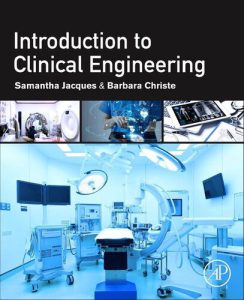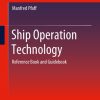Introduction to Clinical Engineering 1st Edition by Samantha Jacques 9780128181041 0128181044
$50.00 Original price was: $50.00.$25.00Current price is: $25.00.
Introduction to Clinical Engineering 1st Edition Samantha Jacques – Ebook Instant Download/Delivery ISBN(s): 9780128181041 0128181044

Product details:
- ISBN 10:0128181044
- ISBN 13:9780128181041
- Author: Samantha Jacques
Introduction to Clinical Engineeringfocuses on the application of engineering practice within the healthcare delivery system, often defined as clinical engineering. Readers will explore the fundamental concepts integral to the support of healthcare technology to advance medical care. The primary mission of clinical engineers is the utilization of medical devices, software, and systems to deliver safe and effective patient care throughout technology’s lifecycle. This unique and interdisciplinary workforce is part of the healthcare team and serves as the intersection between engineering and medicine.
This book is aimed at practitioners, managers, students, and educators to serve as a resource that offers a broad perspective of the applications of engineering principles, regulatory compliance, lifecycle planning, systems thinking, risk analysis, and resource management in healthcare. This book is an invaluable tool for healthcare technology management (HTM) professionals and can serve as a guide for students to explore the profession in depth.
- Offers readers an in-depth look into the support and implementation of existing medical technology used for patient care in a clinical setting
- Provides insights into the clinical engineering profession, focusing on engineering principles as applied to the US healthcare system
- Explores healthcare technology, hospital and systems safety, information technology and interoperability with medical devices, clinical facilities management, as well as human resource management
Table contents:
1 The profession
Introduction
What is clinical engineering?
Historical perspective
The profession
Academic pathways
Certification and credentialing
Responsibilities and roles
Potential employers and career pathways
Societies and collaboration
American College of Clinical Engineering
Association for the Advancement of Medical Instrumentation
American Society for Health Care Engineering
Local societies
Professional development
Code of ethics
American College of Clinical Engineering code of ethics
Biomedical Engineering Society code of ethics
Future opportunities for clinical engineering
Abbreviations
References
2 Healthcare technology basics
General types of medical technologies utilized in clinical settings
FDA definition and categorization
EQ89 standard definition
Regulatory definition and categorization
High-risk (critical) equipment vs. non–high-risk (non-critical) equipment
Devices throughout the healthcare system and relationship to patient care
Introduction
Scenario 1: Outpatient surgery/procedures
Scenario 2: Clinic visit (stress test) to emergency department to surgery
Outpatient environments
Clinics
Emergency department
Observation units
Home health
Telehealth
Inpatient patient care areas
Operating room
Procedural areas (cardiac catheterization, endoscopy)
Pre-procedure and post-procedure rooms/bays
Intensive care unit
Intermediate care unit/continuing care unit
Acute care—common patient care rooms
Labor and delivery
Pediatric and neonatal areas
Other equipment used across the hospital
Other specialty areas
Imaging
Nuclear medicine
Clinical laboratory
Pharmacy
Sterile processing
Technology support life cycle
Introduction
Medical device inventory
Pre-procurement evaluation and selection
Request for Information
Request for Proposal
Selection and acquisition
New device installation/integration
Operation: repair and maintenance processes
Device retirement planning
De-installation and disposition
Abbreviations
References
3 Healthcare technology management
Systems engineering theory as applied to the clinical setting
The human-device interface and human factors
Computerized maintenance management systems
Asset tracking
Work order management
Preventative maintenance work orders
Reactive maintenance work orders
Other types of work orders
Equipment-based work order types
Non-equipment-based work order types
Labor tracking
Parts management
Contracts management
Reporting
Medical device interoperability
Project management principles, as applied to clinical engineering
Ongoing support planning including service agreements
Background
Service-level agreements
Operational-level agreements
Device-specific support plans
Scope
Defining roles and responsibilities
Draft support plan
Vendor contracting and vendor management
Pre-purchase vendor contracting
Post-purchase vendor management
Data-driven decisions and data analytic techniques
Financial management of medical technology
Budget management
Capital planning
Return-on-investment analysis
Clinician connections including communication and collaboration
Alarm management and secondary device notification
Device/disposable standardization
Research
Emerging technologies and technology transfer into healthcare settings
Abbreviations
References
4 Safety and systems safety
Introduction
Regulations, regulatory bodies, codes, and standards
Government regulations
Medical device safety
Fire safety
Radiation safety
LASER safety
Cybersafety
Infection control
Research activities and the Institutional Review Board
Medical device incidents
Investigation
Root cause analysis
Reporting requirements
Recall management
Risk management
Quality management practices
Abbreviations
References
5 Information technology
The clinical engineering–information technology interface
Interoperability and integration of medical device data
Integration to medical records
Pull workflows
Push workflows
Picture archiving and communication system integration
Laboratory information systems
Decision support algorithms
Secondary device notification systems
Telemedicine
Medical devices at home
Cybersecurity, threats, vulnerabilities, and mitigation
Ransomware
Denial-of-service attack
Formjacking
Cybersecurity of medical devices
Cybersecurity incident response plans
Abbreviations
References
6 Facilities management
Introduction
Electrical power
Plumbing systems and water quality management
Dialysis systems
Sterile processing systems
Laboratory systems
Emergency plumbing systems
Water quality management
Medical gas systems
Oxygen
Vacuum
Waste anesthetic gas disposal
Medical air
Heating, ventilation, and air-conditioning systems
Positive- and negative-pressure rooms
Air-conditioning for the operating room
Building and renovation project management
Emergency preparedness
Weather-related events
Security events
Large-scale events
Cyberattacks
Summary
Infection prevention
Hand hygiene
Hospital-acquired infections
Abbreviations
References
7 Human resource management
Workforce development, job descriptions, and succession planning
Workforce development
Job description
Succession planning
Strategic planning, goal development/cascading, and performance evaluations
Introduction
Strategic planning
Goal development and cascading
Performance evaluations
Change management
Change management models
Plan-Do-Check-Act
Plan
Do
Check
Act
Kotter’s Leading Change eight-step management process
Reacting to change
Culture of safety
Error prevention
Skill-based errors
Rule-based errors
Knowledge-based errors
STAR
Three-way repeat back
SBAR
ARCC
Stop the line
Project management
People also search:
introduction to clinical engineering
introduction to clinical engineering pdf
introduction to medical physics and clinical engineering
introduction to engineering courses
introduction to clinical emergency medicine
You may also like…
Reference - Other Reference By Subject
Engineering - Bioengineering
Introduction to Environmental Engineering 6th Edition Mackenzie Davis
Computers - Programming
Engineering - Engineering - General & Miscellaneous
Introduction to Reliability Engineering by James E. Breneman 9781119640653 1119640652
Computers - Organization and Data Processing
Engineering - Engineering - General & Miscellaneous
Engineering Fundamentals: An Introduction to Engineering, 6th Edition Moaveni Saeed












